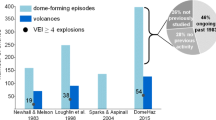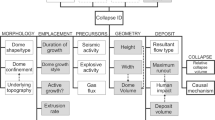Abstract
Popocatépetl volcano reawakened in 1994 after nearly 70 years of quiescence. Between 1996 and 2015, a succession of at least 38 lava domes have been irregularly emplaced and destroyed, with each dome reaching particular volumes at specific emplacement rates. The complexity of this sequence is analyzed using statistical methods in an attempt to gain insight into the physics and dynamics of the lava dome emplacement and destruction process and to objectively assess the hazards related to that volcano. The time series of emplacements, dome residences, lava effusion lulls, and emplaced dome volumes and thicknesses are modeled using the simple exponential and Weibull distributions, the compound non-homogeneous generalized Pareto–Poisson process (NHPPP), and the mixture of exponentials distribution (MOED). The statistical analysis reveals that the sequence of dome emplacements is a non-stationary, self-regulating process most likely controlled by the balance between buoyancy-driven magma ascent and volatile exsolution crystallization. This balance has supported the sustained effusive activity for decades and may persist for an undetermined amount of time. However, the eruptive history of Popocatépetl includes major Plinian phases that may have resulted from a breach in that balance. Certain criteria to recognize such breaching conditions are inferred from this statistical analysis.






Similar content being viewed by others
References
Akaike H (1973) Information theory as an extension of the maximum likelihood principle. In: Petrov BN, Csaki F (eds) Second International symposium on information Theory. Akademiai Kiado, Budapest, pp 267–281
Akaike H (1974) A new look at the statistical model identification. IEEE Trans Autom Control AC-19:716–723
Barmin A, Melnik O, Sparks RSJ (2002) Periodic behavior in lava dome eruptions. Earth Planet Sci Lett 6184:1–12. doi:10.1016/S0012-821X(02)00557-5
Boudal C, Robin C (1989) Volcán Popocatépetl: recent eruptive history, and potential hazards and risks in future eruptions. In: Latter JH (ed) Volcanic hazards. IAVCEI Proc Volcanol, Springer, Berlin, pp 110–128
Bebbington MS (2007) Identifying volcanic regimes using Hidden Markov Models. Geophys J Int 171:921–942. doi:10.1111/j.1365-246X.2007.03559.x
Bebbington MS, Lai CD (1996a) On nonhomogeneous models for volcanic eruptions. Math Geol 28:585–600
Bebbington MS, Lai CD (1996b) Statistical analysis of New Zealand volcanic occurrence data. J Volcanol Geotherm Res 74:101–110
Bradson BB, Palutikov JP (2000) Test of the generalized Pareto distribution for predicting extreme wind speeds. J Appl Meteorol 39:1627–1640
Burnham KP, Anderson DR (1998) Model selection and inference: a practical information-theoretic approach. Springer-Verlag, New York, p 353
Calder ES, Lavallée Y, Kendrick JE, Bernstein M (2015) Lava dome eruptions. In: Sigurdsson H, Houghton B, Rymer H, Stix J, McNutt S (eds) Encyclopedia of volcanoes, 2nd Ed. Academic Press, San Diego
Capra L, Macías JL, Scott KM, Abrams M, Garduño-Monroy VH (2002) Debris avalanches and debris flows transformed from collapses in the Trans-Mexican Volcanic Belt, México—behavior, and implication for hazard assessment. J Volcanol Geotherm Res 113(1–2):81–110
Cashman K, Blundy J (2000) Degassing and crystallization of ascending andesite and dacite. Phil Trans R Soc Lond A 358:1487–1513. doi:10.1098/rsta.2000.0600
Coles S (2001) An introduction to statistical modeling of extreme values. Springer-Verlang, London
Cox DR, Lewis PAW (1966) The statistical analysis of series of events. Methuen and Co., London
Cox DR (1970) Renewal theory. Methuen & Co., London
Cox DR, Isham V (1980) Point processes. Chapman and Hall, London
Cross JK, Roberge J, Jerram DA (2012) Constraining the degassing processes of Popocatépetl volcano, Mexico: a vesicle size distribution and glass geochemistry study. J Volcanol Geotherm Res 225-226:81–95
Davison AC, Smith RL (1990) Models for exceedances over high thresholds. J R Stat Soc 52(B):393–442
De la Cruz-Reyna S, Quezada JL, Peña C, Zepeda O, Sánchez T (1995) Historia de la actividad del Popocatépetl (1354–1995). In: Volcán Popocatépetl, Estudios Realizados Durante la Crisis de 1994–1995. CENAPRED-UNAM, México, D.F, pp 3–22.
De la Cruz-Reyna S, Siebe C (1997) The giant Popocatepetl stirs. Nature 388(6639):227
De la Cruz-Reyna S, Tilling R (2008) Scientific and public responses to the ongoing volcanic crisis at Popocatépetl volcano, México: importance of an effective hazards warning system. J Volcanol Geotherm Res 170:121–134
De la Cruz-Reyna S, Mendoza-Rosas A T (2015) An extreme event approach to volcanic hazard assessment. In: Chavez M, Ghil M, Urrutia-Fucugauchi J (eds) Extreme Events: Observations, Modeling, and Economics, John Wiley & Sons, Inc, Hoboken, NJ. Doi: 10.1002/9781119157052.ch15
De la Cruz-Reyna S, Tilling R, Valdés-González C (2017) Challenges in responding to a sustained, continuing volcanic crisis: the case of Popocatepétl volcano, Mexico, 1994-present. In: Bird D, Jolly G, Haynes K, McGuire B, Fearnley C (Eds) Volcanic crisis communication - observing the volcano world. Advances in Volcanology series, Springer-Verlag. doi:10.1007/11157_2016_37
Delgado-Granados H, Cárdenas-González L, Piedad-Sánchez N (2001) Sulfur dioxide emissions from Popocatépetl volcano (Mexico): case study of a high emission rate, passively degassing eruptive volcano. J Volcanol Geotherm Res 108:107–120
Dzierma Y, Wehrmann H (2010) Eruption time series statistically examined: probabilities of future eruptions at Villarrica and Llaima volcanoes, southern volcanic zone, Chile. J Volcanol Geotherm Res 193:82–92
Ferráes GS (2003) Probabilistic prediction of the next large earthquake in the Michoacán fault – segment of the Mexican Subduction Zone. Geofis Int 42:69–81
Gómez-Vázquez A, De la Cruz-Reyna S, Mendoza-Rosas AT (2016) The ongoing dome emplacement and destruction cyclic process at Popocatépetl volcano, central Mexico. Bull Volcanol 78:58. doi:10.1007/s00445-016-1054-z
Gibbons JP (1976) Nonparametric methods for quantitative analysis, Holt, Rinehart and Winston, New York, USA
González-Mellado A, De la Cruz-Reyna S (2008) A simplified equation of state for the density of silicate hydrous magmas: an application to the Popocatépetl buoyancy-driven dome growth process. J Volcanol Geotherm Res 171:287–300
Ho C-H (1992) Statistical control chart for regime identification in volcanic time series. Math Geol 24(7):775–787
Johnson NL (1966) Cumulative sum control charts and the Weibull distribution. Technometrics 8:481–491
Klein FW (1982) Patterns of historical eruptions at Hawaiian volcanoes. J Volcanol Geotherm Res 12:1–35
Lin XG (2003) Statistical modelling of severe wind gust. In: International Congress on Modelling and Simulation, Townsville, 14-17 July. 2, 620-5.
Macías JL (2007) Geology and eruptive history of some active volcanoes of México. In Alaniz-Álvarez SA, and Nieto-Samaniego AF eds, Geology of México. Geol Soc Am Sp Paper 422: 183–232 doi: 10.1130/2007.2422(06).
Martínez PA (2003) Un Modelo Estadístico para Valores Extremos en Series de datos Actuariales. Universidad Nacional Autónoma de México
Marzocchi W, Bebbington MS (2012) Probabilistic eruption forecasting at short and long time scales. Bull Volcanol 74:1777–1805
McNeil AJ, Saladin T (1997) The peaks over thresholds method for estimating high quantiles of loss distributions. Colloquium 28th International ASTIN Bulletin. Web. http://www.ma.hw.ac.uk/~mcneil/ftp/cairns.pdf. Accessed 13 June 2016
Mendoza-Rosas AT, De la Cruz-Reyna S (2008) A statistical method linking geological and historical eruption time series for volcanic hazard estimations: applications to active polygenetic volcanoes. J Volcanol Geotherm Res 176:277–290
Mendoza-Rosas AT, De la Cruz-Reyna S (2009) A mixture of exponentials distribution for simple and precise assessment of the volcanic hazard. Nat Hazards Earth Syst Sci 9:425–431
Mendoza-Rosas AT, De la Cruz-Reyna S (2010) Hazard estimates for El Chichón volcano, Chiapas, Mexico: a statistical approach for complex eruptive histories. Nat Hazards Earth Syst Sci 10:1159–1170
Mulargia F, Gasperini P, Tinti S (1987) Identifying different regimes in eruptive activity: an application to Etna volcano. J Volcanol Geotherm Res 34:89–106
Ogburn SE, Loughlin SC, Calder ES (2015) The association of lava dome growth with major explosive activity (VEI ≥ 4): DomeHaz, a global dataset. Bull Volcanol 77:40. doi:10.1007/s00445-015-0919-x
Pickands J (1971) The two dimensional Poisson process and extremal processes. J Appl Probab 8:745–756
Reiss RD, Thomas M (2001) Statistical analysis of extreme values. 2nd ed. Birkhauser, Basel.
Robin C, Boudal C (1987) A gigantic Bezymianny-type event at the beginning of modern volcano Popocatépetl. J Volcanol Geotherm Res 31:115–130
Siebe C, Abrams M, Macías JL (1995) Derrumbes Gigantes, Depósitos de Avalancha de Escombros y Edad del Actual Cono del Volcán Popocatépetl. In: Volcán Popocatépetl, Estudios Realizados Durante la Crisis de 1994–1995, CENAPRED-UNAM, México, D.F, pp 195–220.
Siebe C, Abrams M, Macías JL, Obenholzner J (1996) Repeated volcanic disasters in pre-Hispanic time at Popocatépetl, Central Mexico. Past key to the future? Geology 24:399–402
Siebe C, Macías JL (2006) Volcanic hazards in the Mexico City metropolitan area from eruptions at Popocatépetl, Nevado de Toluca, and Jocotitlán stratovolcanoess and monogenetic scoria cones in the Sierra de Chichinautzin volcanic field. Geol S Am S 402:253–329. doi:10.1130/2004.VHITMC.PFG
Siebe C, Salinas S, Arana-Salinas L, Macías JL, Gardner J, Bonasia R (2017). The ∼23,500y 14C BP White Pumice Plinian eruption and associated debris avalanche and Tochimilco lava flow of Popocatépetl volcano, México. J Volcanol Geotherm Res. Doi: 10.1016/j.jvolgeores.2017.01.011
Smith RL (1989) Extreme value analysis of environmental time series: an application to trend detection in ground-level ozone (with discussion). Stat Sci 4:367–393
Taisne B, Jaupart C (2008) Magma degassing and intermittent lava dome growth. Geophys Res Lett 35:L20310. doi:10.1029/2008GL035432
Turner MB, Cronin SJ, Bebbington MS, Platz T (2008) Developing probabilistic eruption forecasts for dormant volcanoes: a case study from Mt Taranaki, New Zealand. Bull Volcanol 70:507–515. doi:10.1007/s00445-007-0151-4
Yang ZL, Xie M (2003) Efficient estimation of the Weibull shape parameter based on a modified profile likelihood. J Stat Comput Simul 73:115–123
Wehrmann H, Dzierma Y (2011) Applicability of statistical eruption analysis to the geological record of Villarrica and Lanín volcanoes, Southern Volcanic Zone, Chile. J Volcanol Geoth Res 200:99–115
Witter JB, Kress VC, Newhall CG (2005) Volcán Popocatépetl, Mexico. Petrology, magma mixing, and immediate sources of volatiles for the 1994–present eruption. J petrology 46(11):2337–2366. doi:10.1093/petrology/egi058
Wolpert RL, Ogburn SE, Calder ES (2016) The longevity of lava dome eruptions. J Geophys Res Solid Earth 121:676–686. doi:10.1002/2015JB012435
Wright R, De La Cruz-Reyna S, Harris A, Flynn L, Gomez-Palacios JJ (2002) Infrared satellite monitoring at Popocatepétl: explosions, exhalations, and cycles of dome growth. J Geophys Res 107:2–16
Acknowledgements
The authors would like to thank both anonymous reviewers and the Associated Editor Dr. J. Fierstein for their constructive comments and suggestions. We thank DGAPA-PAPIIT-UNAM (project IN-106312) for research support. A.T.M-R gratefully acknowledges support from the European Commission (Project VUELCO, grant 282759), and A. G-V. thanks CONACYT for the scholarship 230925.
Author information
Authors and Affiliations
Corresponding author
Additional information
Editorial responsibility: J. Fierstein
Rights and permissions
About this article
Cite this article
Mendoza-Rosas, A.T., Gómez-Vázquez, Á. & De la Cruz-Reyna, S. Statistical analysis of the sustained lava dome emplacement and destruction processes at Popocatépetl volcano, Central México. Bull Volcanol 79, 43 (2017). https://doi.org/10.1007/s00445-017-1127-7
Received:
Accepted:
Published:
DOI: https://doi.org/10.1007/s00445-017-1127-7




